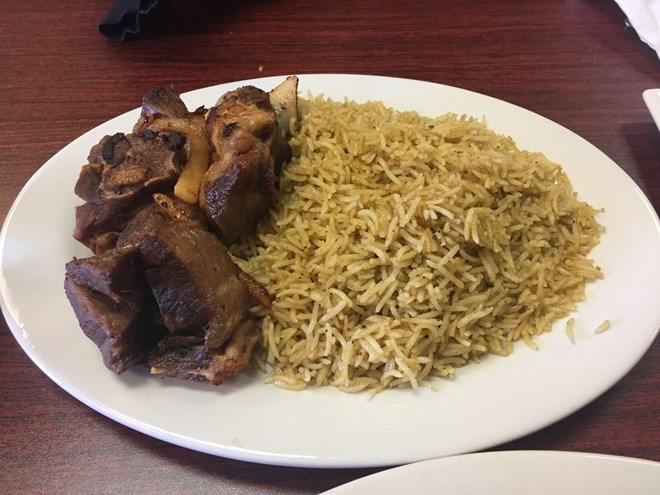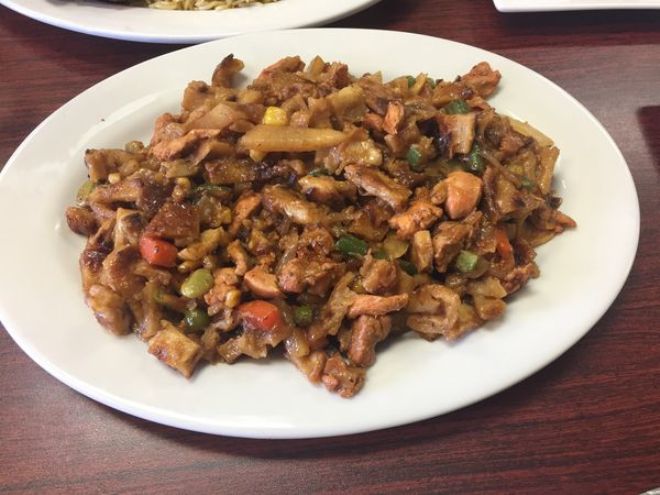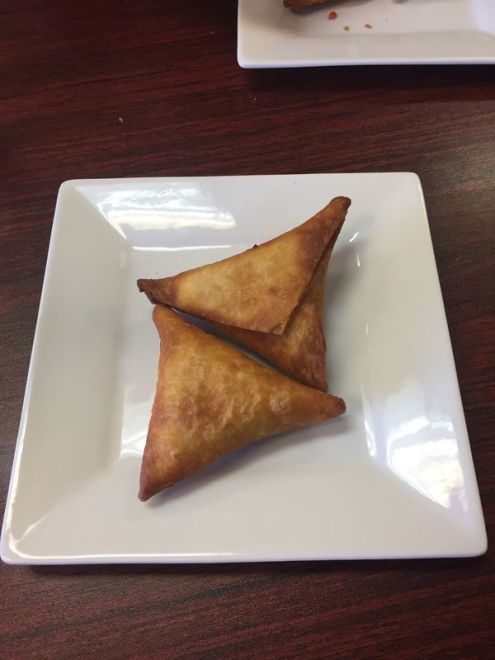ADN
Tuesday March 28, 2017

Goat entree at Safari Restaurant (Photo by Mara Severin)
Given my obsessive pursuit of new dining experiences and my well-documented affection for Anchorage's strip-mall eateries, I'm surprised that Safari Restaurant has managed to stay off my radar for so long.
I would be lying to say that I have been craving a good Somalian meal, being a complete newcomer to this cuisine, but I'm always craving a new culinary adventure, so I grabbed my daughter and headed over to give it a try.
But our first impressions were fleeting. As soon as our presence was noticed, a friendly server, who had been working in the back, found us seats, menus and a couple of bottles of water.
The menu, while brief, represents the cultural melange that is Somalian cuisine. Influenced by Persian and Arab spice traders, the recipes feature cumin, cloves, chili, coriander and garlic. Middle Eastern dishes like hummus and falafel get their own spin. Traditional Indian dishes, like samosas, are on offer. Even European cuisine is represented (because of years of colonization) with spaghetti offered as a side dish with most entrees.
When it came time to order, we opted for the beef samosas, a goat entree (this dish is called, simply, "Goat" on the menu), and then couldn't decide between the more familiar chicken shawarma or the completely-new-to-us kay kay. Our server recommended the kay kay and subtly made our side-dish decision for us. "Would you like spaghetti, rice or bread?" he asked. Then answered his own question. "Rice, I think." Phew. We were glad to put the choice in his hands.
Chicken kay kay (Photo by Mara Severin)
It was while we were waiting for our food that the space seemed to transform from a storefront to a restaurant. Appetizing smells began to emanate from the kitchen. Heaping plates were brought to other tables. Giant trays of fried treats began to come out of the kitchen where they were slid into waiting warmers for to-go orders. There was serious cooking going on behind the scenes.
The samosas ($2.99) arrived and my daughter initially eyed them with suspicion. But after one bite, she was a convert. The pastry was crisp on the outside and comfortingly chewy within. The filling was a perfectly seasoned blend of minced beef, onions, carrot and chilies. There was a subtle hint of cumin and curry. As we were licking our fingers, she was already eyeing the trays of meat pies waiting in the display case. It was clear that we'd be taking some home.
My first two experiences eating goat are within recent memory and involved, in one case, a highly seasoned stew-like tagine and, in another, a complex, fiery curry. Comparatively, this entree ($13.99) was very simple. Large chunks of slow-cooked, bone-in goat with a fairly gentle seasoning rub that hinted of cinnamon and cumin were heaped on a bed of rice. It was like the Somali version of steak and potatoes. While it wasn't the most memorable dish of the day, it was well-cooked and an excellent way to really enjoy the flavor of the goat meat, unmasked by assertive sauces or spices.
Though not quite as tender as lamb, the goat shares lamb's rich, earthy flavor. It's a lovely protein and I wonder why more Americans don't consume it.
A quick side note on the side dish: the rice, while not the star of the plate, was delicious. Savory, highly seasoned, and perfectly al dente, we ate it until we were full. And then we ate some more.
But our favorite dish of the day was the chicken kay kay ($13) recommended by our server. Bite-sized chunks of chicken were sauteed with onions, lima beans, corn and other mixed vegetables. But the intriguing, almost revelatory component of the dish was the thin slices of firm chapati bread that were cooked into it. The bread served the same purpose as a noodle, or a spaetzle-like dumpling, soaking up the spice and the juices from the dish and lending it a comforting, slightly creamy element.
This is a wonderful technique, especially with the flatbread's uniquely dense texture. It doesn't become spongy or mushy at all. This bread is designed to hold its shape and its bite. My daughter has mentioned this dish more than once since we ate it and is already angling for a repeat visit. For a dish that contains lima beans, that is a remarkable feat.
As we ate, one of the restaurant's cooks brought us a plate of freshly fried falafel balls (complimentary in this case, but usually priced at $2.50). I am always charmed by this kind of gesture and think it shows confidence in the kitchen. Indeed, these Somali-style bites (featuring black-eyed peas as opposed to chickpeas), fried to a crispy golden-brown, with a fluffy, garlicky center are addictive and they know it.
"How did you like the food?" our server asked as we paid our bill. "It was delicious," I answered. And I'm sure he believed me because, true to my word, I ordered a sack full of samosas to bring home.